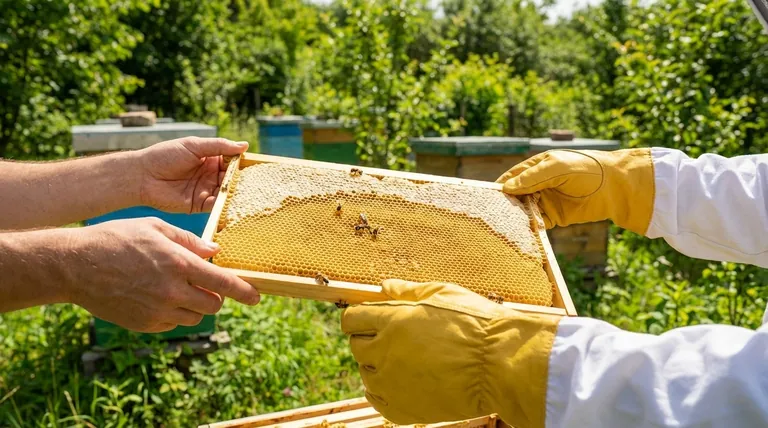The safest way to handle beehive frames is often with your bare hands. This allows for maximum dexterity and tactile feedback, reducing the risk of accidentally crushing bees. A crushed bee releases alarm pheromones, which can trigger a defensive response from the rest of the hive and increase the likelihood of being stung.
The core principle of safe frame handling is that protecting the bees directly protects the beekeeper. While gloves offer a physical barrier, bare hands encourage the gentle, precise movements that keep a colony calm and prevent the very aggression that leads to stings.

The Core Principle: Dexterity and Feedback
Your goal during a hive inspection is to be as minimally disruptive as possible. The concept of "safety" in beekeeping is as much about the colony's well-being as it is about your own.
Why Bare Hands Are Safer for Bees
With bare hands, you can feel the bees on the frame. This immediate sensory feedback makes you instinctively more careful.
You are far less likely to "roll" or crush bees between frames when you can feel their presence. This not only saves individual bees but also prevents a colony-wide defensive reaction.
How This Protects the Beekeeper
The primary trigger for defensive stinging is the release of alarm pheromone, which occurs when a bee is crushed.
By handling frames gently with bare hands, you avoid this trigger. A calm hive has no reason to sting, making the entire inspection safer and more productive for you.
Understanding the Role of Gloves
While bare-handed beekeeping is the ideal for gentle handling, gloves remain an important tool in many situations. They are not a failure, but a specific tool for a specific job.
When Gloves Are a Necessary Tool
For new or nervous beekeepers, the confidence provided by gloves is invaluable. Fear can lead to jerky, sudden movements, which will alarm a hive far more than the choice of hand protection.
Gloves are also essential when dealing with an unusually aggressive or "hot" hive. In these cases, your personal safety from an excessive number of stings is the top priority.
The Downside of Over-Reliance on Gloves
Thick leather gloves remove all tactile feedback. You cannot feel the bees you might be crushing, which can lead to rougher, more disruptive handling.
This creates a false sense of security. You may feel protected, but your clumsy movements could be agitating the colony, inadvertently making the situation more dangerous.
Common Pitfalls to Avoid
Regardless of whether you use gloves, true safety comes from your technique and mindset. Avoiding common mistakes is more important than your choice of equipment.
The Fear-Response Cycle
Being nervous leads to quick, jerky motions. These motions are perceived as a threat by the bees, who then become defensive and may sting. This sting reinforces your fear, creating a negative feedback loop. The key is to break this cycle with calm, deliberate action.
The False Sense of Security
Do not let gloves trick you into being careless. You are a visitor in the bees' home. Banging frames, dropping tools, or moving too quickly will always be met with a defensive response, gloves or not.
Neglecting Other Safety Measures
Gloves are not a substitute for proper beekeeping practice. A well-lit smoker, a reliable hive tool, and a calm demeanor are your most critical safety tools. Always use smoke appropriately to mask alarm pheromones and keep the colony's communication lines interrupted during an inspection.
Making the Right Choice for Your Goal
Ultimately, the choice between bare hands and gloves depends on your confidence level and the specific temperament of your colony.
- If your primary focus is building confidence as a new beekeeper: Start with gloves but make every movement slow and intentional, with the long-term goal of trying an inspection bare-handed on a calm day.
- If your primary focus is managing a calm, established hive: Transitioning to bare hands will improve your dexterity, result in fewer crushed bees, and lead to smoother, more peaceful inspections.
- If your primary focus is dealing with an aggressive or unknown hive: Prioritize your safety and always wear gloves. A calm beekeeper is a safe beekeeper, and gloves can provide the peace of mind needed to work effectively.
Your calm and deliberate presence is the single most important safety tool you can bring to the bee yard.
Summary Table:
| Handling Method | Primary Benefit | Best For |
|---|---|---|
| Bare Hands | Maximum dexterity & tactile feedback; prevents crushing bees | Calm hives, experienced beekeepers |
| Gloves | Physical barrier & confidence for the beekeeper | New beekeepers, aggressive hives |
Ready to handle your frames with confidence and safety?
At HONESTBEE, we supply commercial apiaries and beekeeping equipment distributors with the high-quality, durable tools needed for safe and productive hive management. From reliable hive tools to well-designed smokers, our wholesale-focused operations ensure you have the right equipment to work calmly and effectively.
Let us help you build a safer, more productive operation. Contact our team today to discuss your equipment needs.
Visual Guide

Related Products
- Beekeeping Gloves Goatskin Leather with Long Cotton Sleeve for Beekeepers
- Goatskin Leather Beekeeper Gloves with Vent Long Sleeve for Beekeeping Honey Bee Sting Proof Protection
- Mesh Ventilated 3 Layer Goatskin Beekeepers Gloves for Beekeeping
- Goat Skin Leather Bee Sting Proof Beekeeping Gloves with Canvas Sleeve
- Professional Galvanized Hive Strap with Secure Locking Buckle for Beekeeping
People Also Ask
- Why do some experienced beekeepers choose not to wear gloves? For Superior Dexterity & Hive Welfare
- Why are protective gloves important in beekeeping? Boost Confidence & Safety in Your Apiary
- What are the arguments for and against using gloves in beekeeping? Balancing Protection and Dexterity
- Why is dexterity and flexibility important in beekeeping gloves? Boost Your Hive Management Efficiency
- What are the features of ventilated bee gloves? Stay Cool & Dexterous in Warm Weather



















